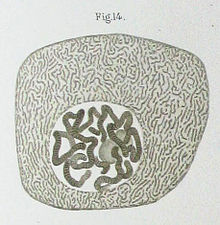- Polytene chromosome
-
 Polytene chromosomes in a Chironomus salivary gland cell
Polytene chromosomes in a Chironomus salivary gland cell
 Polytene chromosomes from Axarus larva
Polytene chromosomes from Axarus larva
To increase cell volume, some specialized cells undergo repeated rounds of DNA replication without cell division (endomitosis), forming a giant polytene chromosome. Polytene chromosomes form when multiple rounds of replication produce many sister chromatids that remain synapsed together.
In addition to increasing the volume of the cells' nuclei and causing cell expansion, polytene cells may also have a metabolic advantage as multiple copies of genes permits a high level of gene expression. In Drosophila melanogaster, for example, the chromosomes of the larval salivary glands undergo many rounds of endoreplication, to produce large amounts of glue before pupation.
Polytene chromosomes have characteristic light and dark banding patterns that can be used to identify chromosomal rearrangements and deletions. Dark banding frequently corresponds to inactive chromatin, whereas light banding is usually found at areas with higher transcriptional activity. The banding patterns of the polytene chromosomes of Drosophila melanogaster were sketched in 1935 by Calvin B. Bridges, in such detail that his maps are still widely used today. The banding patterns of the chromosomes are especially helpful in research, as they provide an excellent visualization of transcriptionally active chromatin and general chromatin structure.
Chromosome puffs are diffused uncoiled regions of the polytene chromosome that are sites of RNA transcription. A Balbiani ring is a large chromosome puff.
Polytene chromosomes were originally observed in the larval salivary glands of Chironomus midges by Balbiani in 1881,[1] but the hereditary nature of these structures was not confirmed until they were studied in Drosophila melanogaster in the early 1930s by Emil Heitz and Hans Bauer. They are known to occur in secretory tissues of other dipteran insects such as the Malpighian tubules of Sciara and also in protists, plants, mammals, or in cells from other insects. Some of the largest polytene chromosomes described thus far (see scale bar in figure below) occur in larval salivary gland cells of the Chironomid genus Axarus. Polytene chromosomes are about 200micron in length. The chromonema of these chromosomes divide but do not separate. Therefore, they remain together to become large in size. Another form of chromosomal enlargement that provides for increased transcription is the lampbrush chromosome.
Polytene chromosomes are also used to identify the species of Chironomid larvae that are notoriously difficult to identify. Each morphologically distinct group of larvae consists of a number of morphologically identical (sibling) species that can only be identified by rearing adult males or by cytogenetic analysis of the polytene chromosomes of the larvae. Karyotypes are used to confirm the presence of specific species and to study genetic diversity in species with a wide range.[2][3]
References
- ^ Balbiani EG (1881). "Sur la structure du noyau des cellules salivaires chez les larves de Chironomus". Zool. Anz. 4: 637–641.
- ^ >Int Panis L, Kiknadze I, Bervoets L, Aimanova A (1994). "Karyological identification of some species of the genus Chironomus Meigen, 1803 from Belgium". Bull. Annls Soc. R. Belge Ent. 130: 135–142.
- ^ >Кикнадзе ИИ, Михайлова П, Истомина АГ, Голыгина ВВ, Инт Панис Л, Крастанов Б (2006). "Хромосомный полиморфизм и дивергенция популяций у Chironomus nuditarsis Keyl (Diptera, Chironomidae)". Tsitologia 48: 595–609.
Other References
- Baudisch W (1977). "Balbiani ring pattern and biochemical activities in the salivary gland of Acricotopus lucidus (Chironomidae)". Results Probl Cell Differ 8: 197–212. PMID 335467.
- Bridges CB (1935). "Salivary chromosome maps with a key to the banding of the chromosomes of Drosophila melanogaster". J Heredity 26: 60–64.
- Daneholt B (1992). "The transcribed template and the transcription loop in Balbiani rings". Cell Biol Int Rep 16 (8): 709–715. doi:10.1016/S0309-1651(05)80015-3. PMID 1446347.
- Werle SF, E Klekowski and DG Smith (2004). "Inversion polymorphism in a Connecticut River Axarus species (Diptera: Chironomidae): biometric effects of a triple inversion heterozygote". Can. J. Zool. 82: 118–129. doi:10.1139/z03-227.
- PAVAN, C. and BREUER, M. E. 1952. Polytene chromosomes in different tissues of Rhynchosciara. Journal of Heredity. vol. 63, p. 151-157.
- PAVAN, C. 1967. Chromosomal changes induced by infective agents Triangle. Sandoz J. Med. Sci. vol. 8, p. 42-48.
- PAVAN, C., BIESELE, J., RIESS, R. W. and WERTZ, A. V. 1971. XIII. Changes in the ultrastructure of Rhynchosciara cells infected by Microsporidia. Studies in Genetics. vol. VI, p. 7103.
- PAVAN, C., DA CUNHA, A. B. and MORSOLETTO, C. 1971. Virus-chromosome relationships in cells of Rhynchosciara (Diptera, Sciaridae). Caryologia. vol. 24, p. 371-389.
External links
[1] (87A&C Heat-shock puffs)
[2] (High resolution spreads)
- Phaseolus Polytene chromosomes (Plants)
Categories:
Wikimedia Foundation. 2010.

